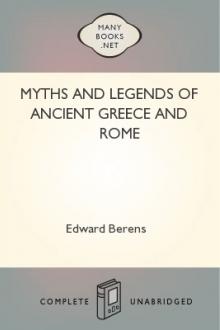Myths and Legends of Ancient Greece and Rome by E. M. Berens (best romantic novels in english txt) 📕

- Author: E. M. Berens
- Performer: -
Book online «Myths and Legends of Ancient Greece and Rome by E. M. Berens (best romantic novels in english txt) 📕». Author E. M. Berens
As the worship of Zeus formed so important a feature in the religion of the Greeks, his statues were necessarily both numerous and magnificent. He is usually represented as a man of noble and imposing mien, his countenance expressing all the lofty majesty of the omnipotent ruler of the universe, combined with the gracious, yet serious, benignity of the father and friend of mankind. He may be recognized by his rich flowing beard, and the thick masses of hair, which rise straight from the high and intellectual forehead and fall to his shoulders in clustering locks. The nose is large and finely formed, and the slightly-opened lips impart an air of sympathetic kindliness which invites confidence. He is always accompanied by an eagle, which either surmounts his sceptre, or sits at his feet; he generally bears in his uplifted hand a sheaf of thunder-bolts, just ready to be hurled, whilst in the other he holds the lightning. The head is frequently encircled with a wreath of oak-leaves.
The most celebrated statue of the Olympian Zeus was that by the famous Athenian sculptor Phidias, which was forty feet high, and stood in the temple of Zeus at Olympia. It was formed of ivory and gold, and was such a masterpiece of art, that it was reckoned among the seven wonders of the world. It represented the god, seated on a throne, holding in his right hand a life-sized image of Nike (the goddess of Victory), and in his left a royal sceptre, surmounted by an eagle. It is said that the great sculptor had concentrated all the marvellous powers of his genius on this sublime conception, and earnestly entreated Zeus to give him a decided proof that his labours were approved. An answer to his prayer came through the open roof of the temple in the shape of a flash of lightning, which Phidias interpreted as a sign that the god of heaven was pleased with his work.
Zeus was first worshipped at Dodona in Epirus, where, at the foot of Mount Tomarus, on the woody shore of Lake Joanina, was his famous oracle, the most ancient in Greece. Here the voice of the eternal and invisible god was supposed to be heard in the rustling leaves of a giant oak, announcing to mankind the will of heaven and the destiny of mortals; these revelations being interpreted to the people by the priests of Zeus, who were called Selli. Recent excavations which have been made at this spot have brought to light the ruins of the ancient temple of Zeus, and also, among other interesting relics, some plates of lead, on which are engraved inquiries which were evidently made by certain individuals who consulted the oracle. These little leaden plates speak to us, as it were, in a curiously homely manner of a by-gone time in the buried past. One person inquires what god he should apply to for health and fortune; another asks for advice concerning his child; and a third, evidently a shepherd, promises a gift to the oracle should a speculation in sheep turn out successfully. Had these little memorials been of gold instead of lead, they would doubtless have shared the fate of the numerous treasures which adorned this and other temples, in the universal pillage which took place when Greece fell into the hands of barbarians.
Though Dodona was the most ancient of his shrines, the great national seat of the worship of Zeus was at Olympia in Elis, where there was a magnificent temple dedicated to him, containing the famous colossal statue by Phidias above described. Crowds of devout worshippers flocked to this world-renowned fane from all parts of Greece, not only to pay homage to their supreme deity, but also to join in the celebrated games which were held there at intervals of four years. The Olympic games were such a thoroughly national institution, that even Greeks who had left their native country made a point of returning on these occasions, if possible, in order to contend with their fellow-countrymen in the various athletic sports which took place at these festivals.
It will be seen on reflection that in a country like Greece, which contained so many petty states, often at variance with each other, these national gatherings must have been most valuable as a means of uniting the Greeks in one great bond of brotherhood. On these festive occasions the whole nation met together, forgetting for the moment all past differences, and uniting in the enjoyment of the same festivities.
It will doubtless have been remarked that in the representations of Zeus he is always accompanied by an eagle. This royal bird was sacred to him, probably from the fact of its being the only creature capable of gazing at the sun without being dazzled, which may have suggested the idea that it was able to contemplate the splendour of divine majesty unshrinkingly.
The oak-tree, and also the summits of mountains, were sacred to Zeus. His sacrifices consisted of white bulls, cows, and goats.
Zeus had seven immortal wives, whose names were Metis, Themis, Eurynome, Demeter, Mnemosyne, Leto, and Hera.
METIS, his first wife, was one of the Oceanides or sea-nymphs. She was the personification of prudence and wisdom, a convincing proof of which she displayed in her successful administration of the potion which caused Cronus to yield up his children. She was endowed with the gift of prophecy, and foretold to Zeus that one of their children would gain ascendency over him. In order, therefore, to avert the possibility of the prediction being fulfilled he swallowed her before any children were born to them. Feeling afterwards violent pains in his head, he sent for Hephæstus, and ordered him to open it with an axe. His command was obeyed, and out sprang, with a loud and martial shout, a beautiful being, clad in armour from head to foot. This was Athene (Minerva), goddess of Armed Resistance and Wisdom.
THEMIS was the goddess of Justice, Law, and Order.
EURYNOME was one of the Oceanides, and the mother of the Charites or Graces.
DEMETER,[13] the daughter of Cronus and Rhea, was the goddess of Agriculture.
MNEMOSYNE, the daughter of Uranus and Gæa, was the goddess of Memory and the mother of the nine Muses.
LETO (Latona) was the daughter of Cœus and Phœbe. She was gifted with wonderful beauty, and was tenderly loved by Zeus, but her lot was far from being a happy one, for Hera, being extremely jealous of her, persecuted her with inveterate cruelty, and sent the dreadful serpent Python[14] to terrify and torment her wherever she went. But Zeus, who had observed with the deepest compassion her weary wanderings and agonized fears, resolved to create for her some place of refuge, however humble, where she might feel herself safe from the venomous attacks of the serpent. He therefore brought her to Delos, a floating island in the Ægean Sea, which he made stationary by attaching it with chains of adamant to the bottom of the sea. Here she gave birth to her twin-children, Apollo and Artemis (Diana), two of the most beautiful of the immortals.
According to some versions of the story of Leto, Zeus transformed her into a quail, in order that she might thus elude the vigilance of Hera, and she is said to have resumed her true form when she arrived at the island of Delos.
HERA, being the principal wife of Zeus and queen of heaven, a detailed account will be given of her in a special chapter.
In the union of Zeus with most of his immortal wives we shall find that an allegorical meaning is conveyed. His marriage with Metis, who is said to have surpassed both gods and men in knowledge, represents supreme power allied to wisdom and prudence. His union with Themis typifies the bond which exists between divine majesty and justice, law, and order. Eurynome, as the mother of the Charites or Graces, supplied the refining and harmonizing influences of grace and beauty, whilst the marriage of Zeus with Mnemosyne typifies the union of genius with memory.
In addition to the seven immortal wives of Zeus, he was also allied to a number of mortal maidens whom he visited under various disguises, as it was supposed that if he revealed himself in his true form as king of heaven the splendour of his glory would cause instant destruction to mortals. The mortal consorts of Zeus have been such a favourite theme with poets, painters, and sculptors, that it is necessary to give some account of their individual history. Those best known are Antiope, Leda, Europa, Callisto, Alcmene, Semele, Io, and Danae.
ANTIOPE, to whom Zeus appeared under the form of a satyr, was the daughter of Nicteus, king of Thebes. To escape the anger of her father she fled to Sicyon, where king Epopeus, enraptured with her wonderful beauty, made her his wife without asking her father's consent. This so enraged Nicteus that he declared war against Epopeus, in order to compel him to restore Antiope. At his death, which took place before he could succeed in his purpose, Nicteus left his kingdom to his brother Lycus, commanding him, at the same time, to carry on the war, and execute his vengeance. Lycus invaded Sicyon, defeated and killed Epopeus, and brought back Antiope as a prisoner. On the way to Thebes she gave birth to her twin-sons, Amphion and Zethus, who, by the orders of Lycus, were at once exposed on Mount Cithaeron, and would have perished but for the kindness of a shepherd, who took pity on them and preserved their lives. Antiope was, for many years, held captive by her uncle Lycus, and compelled to suffer the utmost cruelty at the hands of his wife Dirce. But one day her bonds were miraculously loosened, and she flew for shelter and protection to the humble dwelling of her sons on Mount Cithaeron. During the long period of their mother's captivity the babes had grown into sturdy youths, and, as they listened angrily to the story of her wrongs, they became all impatience to avenge them. Setting off at once to Thebes they succeeded in possessing themselves of the town, and after slaying the cruel Lycus they bound Dirce by the hair to the horns of a wild bull, which dragged her hither and thither until she expired. Her mangled body was cast into the fount near Thebes, which still bears her name. Amphion became king of Thebes in his uncle's stead. He was a friend of the Muses, and devoted to music and poetry. His brother, Zethus, was famous for his skill in archery, and was passionately fond of the chase. It is said that when Amphion wished to inclose the town of Thebes with walls and towers, he had but to play a sweet melody on the lyre, given to him by Hermes, and the huge stones began to move, and obediently fitted themselves together.
The punishment of Dirce at the hands of Amphion and Zethus forms the subject of the world-renowned marble group in the museum at Naples, known by the name of the Farnese Bull.
In sculpture Amphion is always represented with a lyre; Zethus with a club.
LEDA, whose affections Zeus won under the form of a swan, was the daughter of Thestius, king of Ætolia. Her twin-sons, Castor and (Polydeuces or) Pollux,[15] were renowned for their tender attachment to each other. They were also famous for their physical accomplishments, Castor being the most expert charioteer of his





Comments (0)